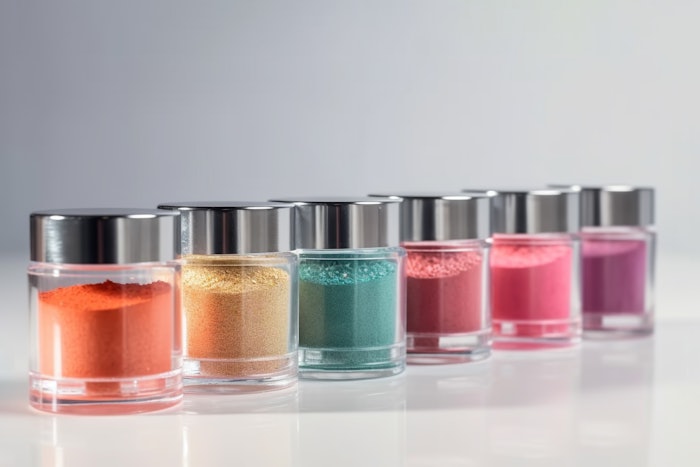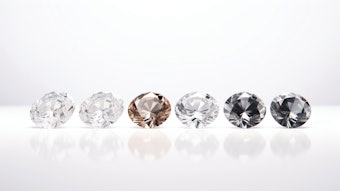
Where did dipping systems come from? I honestly didn’t know, so I had to start asking questions! According to two trusted industry contacts (Doug Schoon and Elaine Watson), the dipping technique was invented in the 1990s by Korean nail technicians in New York City as an offshoot of the 1980s silk-wrap trend, exchanging acrylic powder for fiber to make a stronger nail.
Soon, it was observed that some customers with acrylic monomer allergies could wear the dipping systems without problems. Another factor driving acceptance is that glue has much less odor than monomer, according to OPI education Manager for NA, Lia Smith. As a result of these two advantages, the technique began to spread. It wasn’t long before manufacturers heard about the technique and launched “official” systems in response.
How do dipping systems work?
The method of application is probably well known to most Nailpro readers. However, if that’s not the case for you, there are a number of application videos on the internet, such as this one.
However, the short version of the protocol includes the following.
Step 1. Coat a prepped nail with base resin, dip into powder and dust the excess.
Step 2. Repeat the resin/powder process 2-3 times to build up the nail. -
Step 3. Apply 1-2 coats of activator (depending on manufacturer’s instructions) and wait for nails to harden.
Step 4. After hardening, shape and contour the nails as needed, and buff smooth.
Step 5. Finally, apply and dry activator again, followed by two layers of clear topcoat.
There are several variations on this, e.g., some techs use the activator after each layer, some systems use a clear powder for the third layer and some techs prefer to pour the powder over the nails rather than actually dipping.
Chemistry of the Dip
 Diana Vyshniakova in Adobe Stock
Diana Vyshniakova in Adobe Stock
Basecoat. The basecoat is made of a chemical called “ethyl cyanoacrylate.” This material has long been used in the nail industry as a tip glue and has applications in other industries as well. Hardware brands such as “Super Glue” and “Krazy Glue” are also cyanoacrylates, as are some medical wound-closure glues.
As the name suggests, “cyanoacrylate” is “cyano + acrylate,” a chemical relative of the methacrylates and acrylates in other nail products. The “cyano” group, despite its scary name, is NOT something that can generate cyanide. This question has been asked. Instead, the cyano-group changes the reactivity, allowing the resin to cure tack-free. So, there is no wiping step or wet residue to worry about.
Powder. Dip powder, like sculpting powders, is composed of very small beads of polyethyl methacrylate (PEMA), often with some polymethyl methacrylate (PMMA) added. Benzoyl peroxide (BPO) may also appear in the ingredient list, either as a leftover from manufacture, or at a higher level if the powder is intended for dual use (sculpting + dipping).
As with conventional liquid/powder systems, dipping powder dissolves into cyanoacrylate resin to a certain extent. These molecules reinforce the cyanoacrylate, creating a much stronger coat than cyanoacrylate alone.
Activator. Although cyanoacrylates will cure on exposure to water vapor, they will cure much faster if an activator is used. Originally activators were sprays, but due to odor concerns some companies have moved to brush-on formulations. The active ingredients are generally of the toluidine/tolylamine family.
Topcoat. The topcoat is also made of cyanoacrylate and may be very similar to the basecoat formulation. Since it is not mixed with powder during application, it makes a clear, tack free final layer.
Why are dipping systems so popular now?
As noted, dip systems are decades old. However, while liquid/powder systems dominated the industry, dipping systems were largely confined to a core of dedicated users, and clients who didn’t react well to conventional acrylics. When UV cured gels became widespread, so did a new issue: fear of UV lamp exposure. Research has shown that this exposure is well within safety limits, but many people don’t know this. These customers formed a ready market for the dipping systems, which do not require UV light.
It’s not just fear that drives the trend. There are many positive reasons why dipping systems are popular now. Among the advantages of dip systems are the following.
- Long lasting and durable colors
- Different colors and artistic effects can be made by blending powders
- Much less odor than lacquer
- No tacky residue as with many gels
- Low cost of entry (no need for a UV lamp)
- Although harder to remove than gels, dips can be removed by soaking-off.
- Glitter, crystals or other nail art can be added without worrying about blocking light cure.
Safety Considerations
As with all products, follow the manufacturer’s directions. All the usual chemical precautions hold, such as keeping out of reach of children and so on. However, note that cyanoacrylate bonds skin and eyes instantly. If on the skin, loosen with water. If in the eyes, go to the emergency room. Cyanoacrylate and activator liquids are flammable. Cyanoacrylate, spilled on a cloth towel or clothing, can cure so fast and hot that it smokes (and can cause a painful burn underneath). Dipping powders are made of small round beads, so any spill creates a slip hazard.
There are also sanitary concerns raised with the dipping powders. Although dry powders don’t support microbes, mechanical transfer of fungus and other pathogens is possible. For this reason, best practices (and regulations) dictate that powder that’s been in contact with a client cannot be reused. So don’t dip the client’s finger in the main container or pour powder back into it. Instead, measure enough powder for one client into a small cup, and dispose of the excess after finishing that client.
What’s Next for Dips
That’s totally up to you and your artistic talents. New forms of dip-based nail art are constantly being launched. I can only suggest consider the advantages and, if you haven’t already done so, give dipping systems a try!
About the Author:
Paul Bryson, Ph.D., is one of the principal scientists at Wella-OPI and has been with for the OPI brand for over 25 years.












